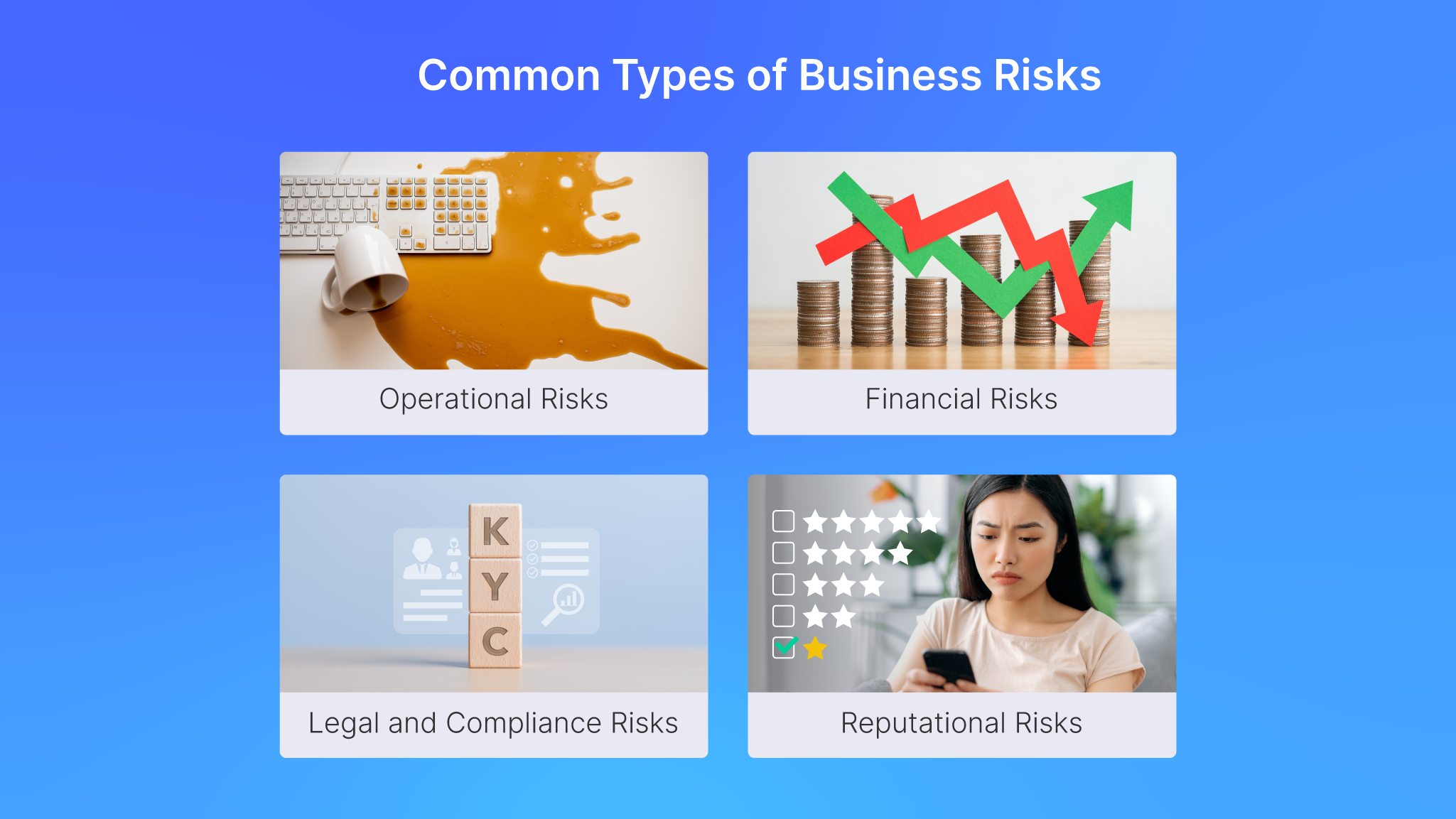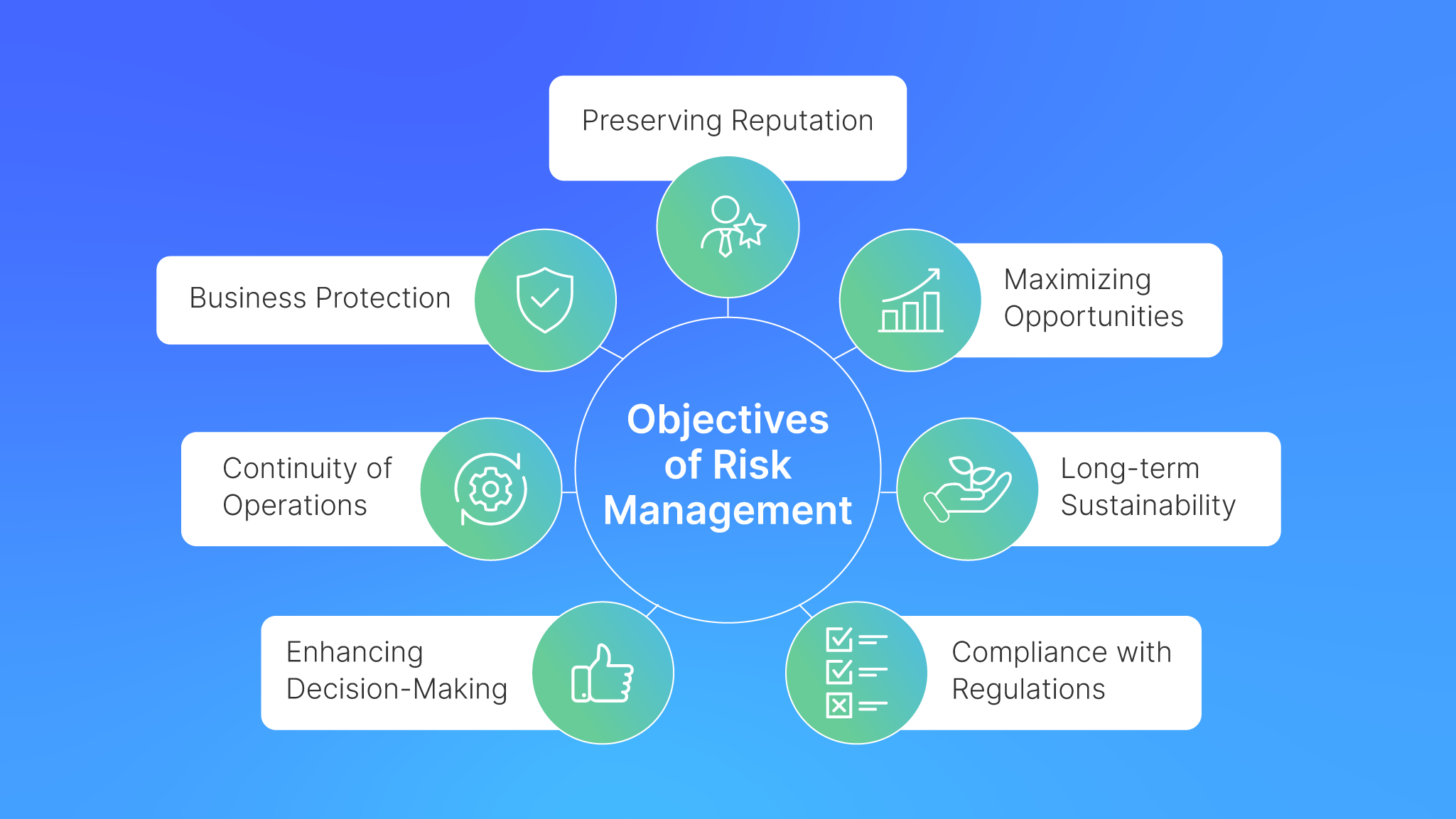
For savvy entrepreneurs and business leaders like yourself, understanding risk management and its profound impact on the bottom line is not just beneficial—it’s a decisive factor that can determine the trajectory of success.
By integrating risk management into the very fabric of a business’s operational framework, entrepreneurs can foster resilience, enhance decision-making, and drive sustainable growth.
In this 3-part series on risk management, we will help you understand various concepts you need to start benefiting from risk management practices. We will:
- Explore the different types of business risks and the pivotal role of risk management, then,
- Provide businesses with an effective risk management framework that can be easily be integrated into business operations, and lastly,
- Introduce the concept of Enterprise Risk Management (ERM) and its relevance in today’s business climate.
What is risk management?
Risk management refers to the systematic approach of identifying, analyzing, and addressing potential risks that could hinder the achievement of business objectives. It involves assessing the likelihood and impact of various risks, taking proactive measures to minimize their negative consequences, and capitalizing on potential opportunities.
It goes beyond a reactive approach to crisis management; rather, it entails a proactive mindset that anticipates and prepares for potential disruptions while optimizing the use of available resources.
This holistic methodology encompasses a spectrum of activities, from risk identification and analysis to mitigation strategies and continuous monitoring.
Common types of business risks
Before developing an effective risk management plan, it is crucial to have a clear understanding of the common types of risks that businesses face. While the specific risks can vary depending on the industry and nature of your business, there are several broad categories that encompass most risks:
1. Operational risks
These risks refer to potential issues or failures in your day-to-day operations. Operational disruptions can not only lead to financial losses but also dent customer satisfaction and erode stakeholder confidence. By identifying and mitigating operational risks, you can ensure the smooth functioning of your business and minimize potential disruptions.
Examples of operational risks: Equipment breakdowns, supply chain disruptions, employee errors, or even natural disasters.
2. Financial risks
Financial risks encompass risks related to your organization’s financial stability and performance. Effectively managing financial risks helps your business maintain a healthy financial position and avoid potential financial crises.
Examples of financial risks: Market volatility, liquidity issues, credit risks, or inadequate financial controls.
3. Legal and compliance risks
Legal and compliance risks refer to risks associated with regulatory requirements, legal obligations, and potential lawsuits. As businesses expand their footprint, engage with partners, and interact with consumers, they become subject to an array of laws and regulations that span industries and sectors. From corporate governance and employment laws to industry-specific regulations and data privacy requirements, the spectrum of legal considerations can be vast and intricate. That’s where a proactive approach to legal and compliance risk management becomes paramount.
Examples of legal and compliance risks: Non-compliance with industry regulations, intellectual property disputes, or employment law violations
4. Reputational risks
Reputational risks are risks that can damage the reputation and brand image of your business. In a digitally connected world, news, opinions, and reviews travel faster than ever before, influencing how consumers and stakeholders perceive a brand. Especially in marketplaces like Indonesia, which is characterized by dynamic consumer behavior and localized sensitivities, the need for businesses to foster a good reputation is even greater. A reputational crisis, whether arising from a product recall, ethical misstep, or mishandled customer concern, can lead to severe consequences that reverberate across industries.
With potential impacts ranging from diminished customer loyalty to waning investor trust, the ripple effects of reputational damage can jeopardize even the most established enterprises.
Examples of reputational risks: Negative publicity, customer complaints that turn viral, or social media backlash.
Understanding these common types of risks is the first step in building a risk management strategy for your business. You can then tailor your strategies to address the specific challenges and vulnerabilities of your business.
Objectives of risk management and its roles in business success
Now that you understand the different types of business risks, let’s look at the role of risk management in the success of your business.
1. Business protection
The primary objective of risk management is to safeguard your business from potential harm. Identifying potential threats and vulnerabilities enables you to implement targeted measures to safeguard your organization from financial losses and operational disruptions. Whether it’s preparing for unforeseen economic downturns or mitigating the impact of supply chain disruptions, risk management serves as a protective shield that ensures your business remains resilient in the face of challenges.
2. Preserving reputation
Your business’s reputation is one of its most valuable assets. One misstep, one miscommunication, and your brand’s reputation could be at stake. The proactive management of reputational risk is, therefore, an indispensable facet of modern business strategy.
Effective risk management involves anticipating reputational risks and proactively crafting strategies to address them. For example, staying attuned to public sentiment, monitoring social media, and swiftly addressing issues, will go a long way in helping you uphold the integrity of your brand and maintain the trust of your stakeholders. Other than this, businesses can also take a proactive stance by nurturing a culture of transparency, accountability, and ethical conduct.
3. Continuity of operations
Operational disruptions, whether due to technological glitches, regulatory changes, or unforeseen events, can paralyze business activities. Risk management ensures that your operations are fortified against potential disruptions, enabling your business to maintain its momentum even in challenging times.
Some proactive measures include business continuity planning, disaster recovery strategies, and regular stress tests. These would help to maintain your business’s ability to deliver products or services to your customers. They also serve to keep you ahead of the game and your competitors during turbulent times, such as the COVID-19 outbreak.
4. Maximizing opportunities
Risk management is not just about avoiding negative events; it is also about capitalizing on positive events and opportunities. Through effective risk assessment, you can identify new markets, innovative technologies, and strategic partnerships that can propel your business forward. Seizing opportunities could then drive sustainable growth and bring your business to greater heights.
5. Enhancing decision-making
Effective risk management provides you with valuable information and insights that can enhance your decision-making process. By thoroughly assessing risks and weighing potential outcomes, you can make informed choices that align with your business objectives. This includes evaluating the potential impact of risks on financial performance, market share, and customer satisfaction.
6. Compliance with regulations
The regulatory landscape is ever-evolving, and compliance is not an option—it’s a necessity. Risk management ensures that your business remains in line with legal and regulatory requirements, avoiding costly fines and legal entanglements.
This includes staying updated with industry-specific regulations, data privacy laws, and financial reporting requirements. Stay ahead of compliance changes so that you can adapt your strategies accordingly and maintain a strong foundation for business operations.
7. Long-term sustainability
Ultimately, the goal of risk management is to ensure the enduring success and sustainability of your business. By embracing risk management as an integral part of your business strategy, you are setting the stage for long-term growth and resilience. Your ability to navigate uncertainties and capitalize on opportunities positions your business for sustained success in a rapidly evolving market.
Read on to find out how to apply risk management strategies to your business
We hope that this first part of our risk management series has set the stage for you to better understand the concepts of risk management and how it relates to business success.
As a recap, risk management is a proactive approach that empowers your business to thrive amidst challenges and uncertainties. From protecting your assets to seizing opportunities and upholding your reputation, risk management can guide your business towards lasting success. By integrating risk considerations into every facet of your business, you forge a path towards resilience, growth, and prosperity in the ever-changing landscape of business.
Next, we will delve into practical steps on how to craft an effective risk management plan for businesses. Keep a lookout for part 2 of the series!











